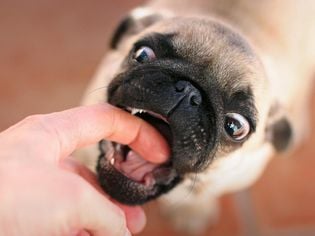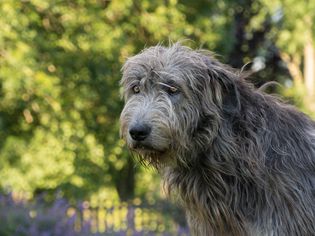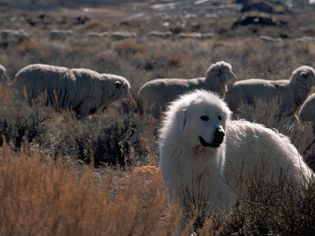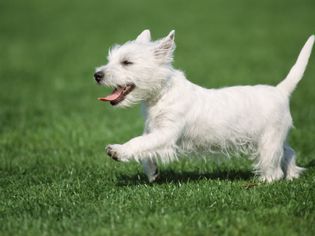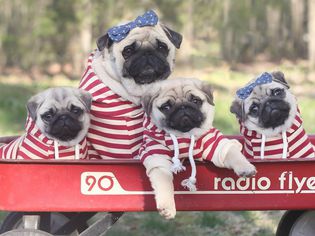Dogs are usually very food-motivated, so if your dog stops eating, it is natural to be a little concerned. There are a variety of causes, and some are more serious than others. Anorexia, for example, is a complete lack of appetite. Your dog is refusing any food and not eating anything. Hyporexia, by contrast, is a decreased appetite or a reluctance to want to eat. It is important to note the difference when you are discussing the severity of your pet's symptoms with your veterinarian, as different issues will cause different levels of changes in appetite. People usually associate the term anorexia with anorexia nervosa, which is an eating disorder in people, but anorexia simply occurs when a dog refuses to eat. Knowing why a dog has stopped eating, if and how you should force it to eat, and when you should be concerned is important to understand as a pet owner.
Why Do Dogs Stop Eating
There are a number of reasons why a dog may refuse to eat. Some reasons can be due to behavior but other, more serious issues, can result from a disease or problem with your dog.
Behavioral
Some dogs become picky eaters after being spoiled by well-intentioned dog owners and refuse to eat unless they get what they want. Regular changes in the pet food you are feeding, lots of treats, and spoiling with table foods can cause behavioral issues resulting in anorexia.
Disease
Any time a dog doesn't feel well, due to an illness or disease, it may not want to eat. Liver and kidney disease, intestinal disease or blockage, respiratory disease resulting in breathing issues, cancer, and other problems may all cause a dog to stop eating. Lethargy and other symptoms, like vomiting and diarrhea, are also often present alongside anorexia in a sick dog.
Pain
Any type of joint, muscle or back pain, mouth pain, abdominal discomfort, and other issues can cause enough discomfort to make a dog reluctant to bend its head and eat food.
Dental Issues
Dental issues, including broken teeth, periodontal disease, and even a stick stuck in the roof of the mouth of a dog can result in anorexia in your dog.
Environmental Changes
If your dog is stressed or fearful—because of a new puppy or person in the household; a new environment; or because of home construction and other changes around the home—it may refuse to eat.
Side Effects
Medications that your dog may be taking may cause it to not want to eat. Discuss this with your veterinarian to see if a dose can be changed or if something else can be done to decrease the side effects. In addition to medications, recent vaccinations can also cause a dog to not feel well and therefore not want to eat.
Obstruction
Some dogs eat things like socks, stuffed animals, rocks, and other items that aren't digestible. This can result in an obstruction and make your dog not want to eat.
What to Do if Your Dog Isn't Eating
You shouldn't force your dog to eat. Instead, if a dog is losing weight, your veterinarian may instruct you to provide assisted feeding to your dog. Watered-down canned food or special formulations can be used to syringe food into a dog's mouth, but this must be done slowly. If force-fed too quickly or if your dog refuses to swallow the food, your dog could aspirate, resulting in food going into the airway instead of the esophagus. It is not recommended to attempt to force feed your dog without specific instructions and direction from your veterinarian. Because there are other, safer, more effective ways to improve your dog's appetite, force feeding dogs is rarely recommended.
The safest thing to do if you are ever concerned about your pet's health or behavior is to contact your veterinarian. They will be able to guide you in what to look for and when to be concerned. They know your pet's history and may be able to provide tips or food that will get them eating more quickly.
If your dog is refusing to eat but acting normally otherwise, you may continue offering food and monitor your dog for any other changes for 12 to 24 hours. If the anorexia continues or if your dog starts losing weight, is not acting normally, is vomiting, has diarrhea, or you notice any other changes in your dog, contact your veterinarian right away. Share with your veterinarian any food or treats that your dog has been eating and when you first noted the changes in appetite. Alongside a physical examination, X-rays, blood screening, and other tests may need to be run to determine the cause of your dog's anorexia.
Treatment & Prevention
If your dog isn't eating, there are a few things you can do to try and entice it to eat at home.
- Call your veterinarian to see if they have tips or a food that they can recommend that would be safe to feed your dog. Your veterinarian is always a great place to call prior to feeding anything new to your pet.
- Warm up your dog's food for a few seconds in the microwave, and always check the temperature to make sure it won't burn your dog's mouth before offering.
- Offer baby food, trying plain turkey or chicken options first. Make sure no additional seasonings or additional foods are added in.
- Feed a bland diet of cooked white rice, and boneless, skinless boiled chicken breast that is not seasoned
- Mix sodium-free chicken broth or water into your dog's food
- Put your dog's food on a plate that a person would eat off of
- Put your dog's food on the floor instead of in a dog bowl or consider raising it if neck or back pain is an issue.
- Sprinkle a small amount of low fat mozzarella or a little peanut butter on the food
Different options may work better than others for your dog, and the efficacy of the options could depend on the cause of your dog's anorexia. Softer foods may be more enticing to a dog with dental issues; warmed food may be more appealing to a dog that cannot smell well due to respiratory issues; and additives like canned chicken or chicken broth may help a picky eater.
As far as prevention, it is important to note, that lots of dogs that are "picky eaters" often suffer from chronic low-grade GI inflammation. This means that they may benefit from a sensitive stomach diet. Discuss your dog's eating habits with your veterinarian to see if she can recommend a diet that will help your pet eat more regularly without the addition of extra toppings or food. These extra toppings can add lots of extra calories that can lead to obesity or cause further GI upset if used frequently.
Keep up on your dog's dental health as well as avoid offering excessive treats or table foods to keep your pup from becoming a picky eater.

